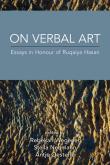AustLit
Latest Issues
AbstractHistoryArchive Description
'Sometimes people motivate you, sometimes they challenge you, sometimes they inspire you, and sometimes they do all three at once. Ruqaiya Hasan falls into the last category. It is impossible to capture the huge impact that her work has had and will continue to have on a wide range of people and areas of research. In this volume, we attempt to show just a small snapshot of her impact on the study of verbal art.
'On Verbal Art reflects on and celebrates the contribution that Professor Ruqaiya Hasan made to research on linguistic approaches to verbal art and includes contributions by scholars from around the world. The volume gathers together researchers with different perspectives, different views and different approaches to verbal art and aims to provide an inspiration to others to continue the work that Hasan began.
'One of the lasting insights emerging from Hasan’s work on verbal art is the extent to which it informs analysis and theory. This volume brings together chapters that offer a detailed account of Hasan’s contribution to the study of verbal art, chapters that pay tribute to Hasan by adopting some of her central notions such as foregrounding, symbolic articulation, theme and secondary semiosis to inform their analyses, chapters that take Hasan’s thinking as a starting point to explore new methodological approaches for the investigation of verbal art, and finally chapters by scholars who are new to Hasanian thinking and afford fresh perspectives that build bridges to related approaches.
'It is also hoped that this volume will encourage new research and promote the reading or re-reading of Hasan’s tremendous work in this area. We look forward to new challenges, arguments, extensions and applications.'
Source: Publisher's blurb.
Notes
-
Contents indexed selectively.
Contents
-
Foregrounding and Defamiliarization in Peter Carey’s 'Conversations with Unicorns',
single work
criticism
(p. 109-131)
' In a particularly revealing interview from 1977, fiction writer Peter Carey was asked how a reader should approach his stories, namely Conversations with Unicorns. Carey replied: Well, I’d hope that the reader would approach them in a relaxed sort of way, hoping to be amused, or diverted. When he’d finished the story I’d hope he’d have found something new to think about. If I’d really done what I wanted to do he’d keep on thinking about the story for weeks, from time to time. If I was successful beyond my wildest dreams I would have given him (or her) something that would alter his (or her) perception of the world. (Ikin 1977, 38). It is remarkable just how accurately Carey’s comment seems to reflect the compelling nature of his short stories. Rubik (2005) has investigated the haunting effect of Carey’s stories in terms of cognitive schemata and Coste (2003) has argued that the inherent ambiguity of Conversations with Unicorns resists generic classification. A number of critical works mention the story (Ahearne 1980, Hassall 1994, Krstovic 2010, Pons 2001, Snodgrass 2010, Turner 1988) but none deal with it in any significant amount of detail, and until now, there has been no attempt to conduct a stylistic reading of this fascinating and under-studied story. Approaching the text from a systemic functional perspective, I investigate the powerful aesthetic quality of the story in terms of prominent linguistic patterning occurring across various linguistic systems.'
Source: Abstract.




